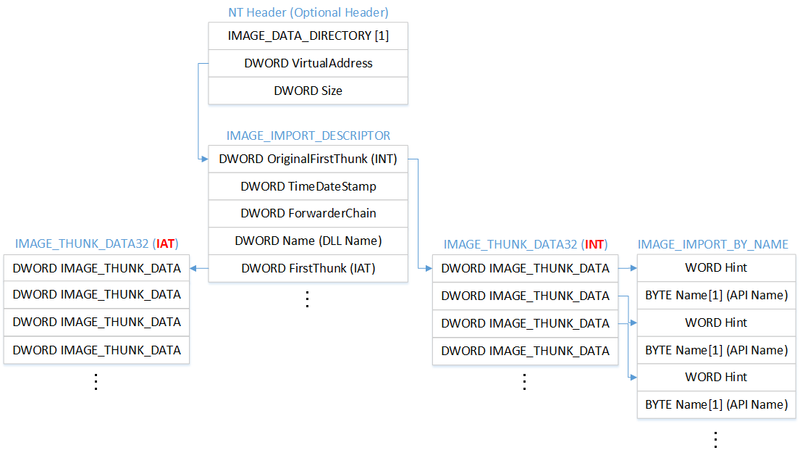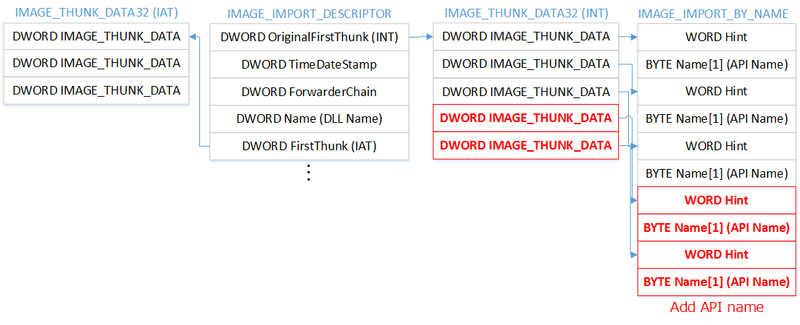Anti-analysis technique for PE Analysis Tools –INT Spoofing–
When analysing Windows executable file type (PE file) malware, a tool to parse and display the PE file’s structure (hereafter “PE analysis tool”) is often used. This tool enables referring to a list of APIs that the malware imports (Import API) and functions that it exports. By analysing the data, it is possible to presume the malware’s function as in communicating with external servers or creating registry entries, etc. In this way, PE analysis tools are often used for malware analysis, however, a type of malware which has techniques to disturb operations of PE analysis tools has already been observed [1].
This entry introduces techniques to deceive analysts by displaying incorrect information in the Import API, and measures to implement in PE analysis tools against the issue.
INT (Import Name Table) and IAT (Import Address Table)
PE files contain 2 address tables related to Import API – INT and IAT. INT describes the address of the area which stores API names imported by the PE file. IAT is used when actually calling an API, and writes an entry address of the functions corresponding to the API when the module which exports the function is loaded. For more information about PE file formats, please refer to Microsoft’s website [2].
NT header in a PE file describes various kinds of information required for executing the file. NT header is structured as “IMAGE_NT_HEADERS”, and INT and IAT can be identified by tracing the address in “IMAGE_DATA_DIRECTORY” of Optional Header within the structure (Figure 1) [3].
 |
The Name field of “IMAGE_IMPORT_BY_NAME” structure, which is referred to by INT, describes importing API names as a string. Generally, IMAGE_IMPORT_BY_NAME lists API names in a sequence as in Figure 2.
 |
INT Spoofing
IMAGE_IMPORT_BY_NAME contains strings specifying API names. Even if someone tries to alter the API name in IMAGE_IMPORT_BY_NAME to disguise it as another PE file, it would not be executed properly since it would import unintended API when executing the PE file. As the red part in Figure 3 indicates, however, if the PE file is modified by adding new API names at the end of the INT to existing API names within the INT, it will not attempt to load a module since the IAT does not have a field that stores the entry address of the functions corresponding to the added API name. If PE analysis tools display such deliberately added API names, analysts would believe that the PE file has new APIs that is imported, which would confuse the analysis.
 |
Check for INT-spoofed PE files using PE analysis tools
Many of the existing PE analysis tools refer to only INT when listing Import API, and recognise and display strings in IMAGE_IMPORT_BY_NAME as API names. When handling normal PE files, there is no issues with the behaviour since importing API addresses corresponding to the strings in IMAGE_IMPORT_BY_NAME, are written in the IAT.
However, if INT is spoofed by the above mentioned method, extra APIs are also listed. As an experiment, JPCERT/CC generated some INT-spoofed PE files, and tested how their Import API would be displayed in several PE analysis tools. As a result, many of them displayed extra APIs that are not actually imported.
 |
Countermeasures against INT spoofing
One countermeasure against such spoofing would be to compare INT and IAT on a PE analysis tool and only display APIs that are actually imported (and not display added API names marked in red in the Figure 3). pyimpfuzzy, which was introduced in a past blog entry, is also a tool which performs analysis based on Import API. In its first version, there was an issue where INT-spoofed samples could not be analysed correctly. As such, the tool was updated with a new feature to compare INT and IAT, and only analyse the APIs that are actually imported.
Many PE analysis tools display strings in IMAGE_IMPORT_BY_NAME as they are. However, many debuggers and IDA refer to IATs when displaying Import API, and thus most of them do not seem to be affected by INT spoofing. When referring to the information on Import API in malware analysis, it is recommended to check APIs that are actually loaded in IAT by using a debugger, as well as INT strings.
Summary
JPCERT/CC has not yet observed any INT-spoofed samples, however, this disguising technique could possibly be abused in the near future. Automated analysis tools based on Import API may be affected by INT spoofing. As introduced above, pyimpfuzzy has been updated to a new version – please make sure that you are using the latest version (version 0.02).
Thanks for reading.
- Shusei Tomonaga
(Translated by Yukako Uchida)
References:
[1] Palo Alto Networks - The Dukes R&D Finds a New Anti-Analysis Technique
http://researchcenter.paloaltonetworks.com/2016/09/unit42-the-dukes-rd-finds-a-new-anti-analysis-technique/[2] Microsoft - PE Format
https://msdn.microsoft.com/en-us/library/windows/desktop/ms680547(v=vs.85).aspx?f=255&MSPPError=-2147217396[3] Microsoft - IMAGE_NT_HEADERS structure
https://msdn.microsoft.com/en-us/library/windows/desktop/ms680336(v=vs.85).aspx

